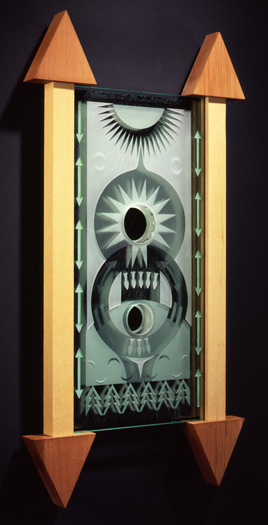Seattle House Post IV/I
EXHIBITION:
Celebrating Women ArtistsThis work will be on loan to the Museum of Indian Arts and Culture (MIAC) for their exhibition, “Clearly Indigenous: Native Visions Re-Imagined in Glass”. The work is available to acquire through our gallery, but will remain on loan until the end of the exhibition.
Glass House Post Series
Susan Point’s series of four unique, mixed medium glass house posts, like much of her work, is a modern interpretation of an old theme or object from the Salish tradition. This collection also acts as a tribute to the southern Salish people of the Seattle area and in particular, Chief Seattle, a powerful chief and statesman who was known for his wisdom and hospitality. These images are a tribute to life in this particular region and the people who lived it.
The indigenous people from Seattle and surrounding areas were known collectively as the Lushootseed, which included groups like the Duwamish, Suquamish, Snohomish, Snoqualmie Nisqually, the Stillaquamish and Puyallup, among others. Chief Seattle had dual citizenship in both the Duwamish and the Suquamish tribes. Susan Point’s ancestors, from what is now known as the Vancouver area, were recognized as the Hunquemi’nim. Together, as Salish people, these two groups gathered together for potlatches, winter spirit dancing, and trading.
Unlike their northern neighbours, the Salish people did not carve totem poles. Instead, they applied carved designs to house posts, the structural posts that were vital in the architecture of the Salish longhouses. Used to support the large roof beams, these posts were notched at the top or carved with a “U” shape at the top where the beams would rest. The Salish added their unique, lightly carved and painted style to these posts, which told of important events and were a great source of pride and a symbol of status.
Unfortunately, few examples of the Salish house posts still exist. Most were destroyed or collected during the time of European contact by eager collectors. Few were even documented, appearing only in occasional European paintings of the interior of longhouses of the time.
In what was originally a series of four glass house post representations, Susan Point incorporated not only the Salish carving style found on the original house posts, but also imagery from baskets, weaving, cornhusk bags and rush mats for which the southern Salish were so famous.
Seattle House Post IV/I
This house post looks forward, representing the generations to come and the role they will play in acting as stewards to the environment and the natural resources available to them. A contemporary image of an adult and a child, this house post also includes the image of the sun, with the moon, earth and stars formed by carved crescents along the outside. Paddles, found within the adult figure, are fabricated out of textured copper and attached as an embellishment. A series of mirrors, located where the heads of the figures are pierces all the way through, add an interactive element to this piece as whoever is looking at the piece will see themselves within it, completing the image of the future. For the border, Point has taken images from flat, twined cornhusk bags and along the bottom, the imagery she has chosen represents trees. The “Tree of Life” image is often found on flat twined bags and beaded bags, and seems appropriate for the theme of the piece.

